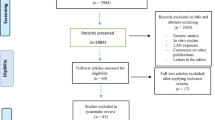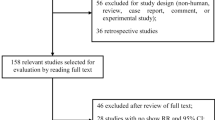Abstract
A 2007 report by the International Agency for Research on Cancer classified night-shift work as possibly carcinogenic to humans, emphasizing, in particular, its association with breast cancer. Since this report and the publication of the last systematic review on this topic, several new studies have examined this association. Hence, to provide a comprehensive update on this topic, we performed a systematic review and meta-analysis. We searched Medline, Embase, CINAHL, Web of Science (Conference Proceedings), and ProQuest dissertations for studies published before March 1, 2012, along with a manual search of articles that cited or referenced the included studies. Included were observational case–control or cohort studies examining the association between night-shift work and breast carcinogenesis in women, which all ascertained and quantified night-shift work exposure. The search yielded 15 eligible studies for inclusion in the systematic review and meta-analysis. Using random-effects models, the pooled relative risk (RR) and 95 % confidence intervals (CIs) of breast cancer for individuals with ever night-shift work exposure was 1.21 (95 % CI, 1.00–1.47, p = 0.056, I 2 = 76 %), for short-term night-shift workers (<8 years) was 1.13 (95 % CI, 0.97–1.32, p = 0.11, I 2 = 79 %), and for long-term night-shift workers (≥8 years) was 1.04 (95 % CI, 0.92–1.18, p = 0.51, I 2 = 55 %), with substantial between-study heterogeneity observed in all analyses. Subgroup analyses suggested that flight attendants with international or overnight work exposure and nurses working night-shifts long-term were at increased risk of breast cancer, however, these findings were limited by unmeasured confounding. Overall, given substantial heterogeneity observed between studies in this meta-analysis, we conclude there is weak evidence to support previous reports that night-shift work is associated with increased breast cancer risk.





Similar content being viewed by others
References
Anonymous (2012) WHO media center fact sheet: cancer. http://www.who.int/mediacentre/factsheets/fs297/en/. Accessed 12 May 2012
Stevens RG (1987) Electric power use and breast cancer: a hypothesis. Am J Epidemiol 125:556–561
Blask DE, Hill SM, Dauchy RT et al (2011) Circadian regulation of molecular, dietary, and metabolic signaling mechanisms of human breast cancer growth by the nocturnal melatonin signal and the consequences of its disruption by light at night. J Pineal Res 51:259–269
Blask DE, Dauchy RT, Brainard GC et al (2009) Circadian stage-dependent inhibition of human breast cancer metabolism and growth by the nocturnal melatonin signal: consequences of its disruption by light at night in rats and women. Integr Cancer Ther 8:347–353
Blask DE, Brainard GC, Dauchy RT et al (2005) Melatonin-depleted blood from premenopausal women exposed to light at night stimulates growth of human breast cancer xenografts in nude rats. Cancer Res 65:11174–11184
Blask DE, Hill SM, Dauchy RT et al (2011) Circadian regulation of molecular, dietary, and metabolic signaling mechanisms of human breast cancer growth by the nocturnal melatonin signal and the consequences of its disruption by light at night. J Pineal Res 51:259–269
Schernhammer ES, Berrino F, Krogh V et al (2010) Urinary 6-Sulphatoxymelatonin levels and risk of breast cancer in premenopausal women: the ORDET cohort. Cancer Epidemiol Biomarkers Prev 19:729–737
Schernhammer ES, Berrino F, Krogh V et al (2008) Urinary 6-sulfatoxymelatonin levels and risk of breast cancer in postmenopausal women. J Natl Cancer Inst 100:898–905
Schernhammer ES, Hankinson SE (2009) Urinary melatonin levels and postmenopausal breast cancer risk in the Nurses’ Health Study cohort. Cancer Epidemiol Biomark Prev 18:74–79
Schernhammer ES, Hankinson SE (2005) Urinary melatonin levels and breast cancer risk. J Natl Cancer Inst 97:1084–1087
Megdal SP, Kroenke CH, Laden F et al (2005) Night work and breast cancer risk: a systematic review and meta-analysis. Eur J Cancer 41:2023–2032
Kolstad HA (2008) Nightshift work and risk of breast cancer and other cancers–a critical review of the epidemiologic evidence. Scand J Work Environ Health 34:5–22
IARC Working Group on the evaluation of carcinogenic risks to humans (2010) Painting, firefighting, and shiftwork. IARC Monogr Eval Carcinog Risks Hum 98:9–764
Kolstad HA, Erlandsen M, Frost P et al (2010) Should we warn against night shifts to prevent breast cancer? Occup Environ Med 67:797
Wise J (2009) Danish night shift workers with breast cancer awarded compensation. BMJ b338:b1152
Stroup DF, Berlin JA, Morton SC et al (2000) Meta-analysis of observational studies in epidemiology: a proposal for reporting. Meta-analysis Of Observational Studies in Epidemiology (MOOSE) group. JAMA 283:2008–2012
Moher D, Liberati A, Tetzlaff J et al (2009) Preferred reporting items for systematic reviews and meta-analyses: the PRISMA statement. BMJ 339:b2535
Greenland S (1987) Quantitative methods in the review of epidemiologic literature. Epidemiol Rev 9:1–30
Walker AM (1991) Observation and inference: an introduction to the methods of epidemiology. Epidemiology Resources, Newton Lower Falls
Royston P, Ambler G, Sauerbrei W (1999) The use of fractional polynomials to model continuous risk variables in epidemiology. Int J Epidemiol 28:964–974
Egger M, Davey Smith G, Schneider M et al (1997) Bias in meta-analysis detected by a simple, graphical test. BMJ 315:629–634
Begg CB, Mazumdar M (1994) Operating characteristics of a rank correlation test for publication bias. Biometrics 50:1088–1101
Reynolds P, Cone J, Layefsky M et al (2002) Cancer incidence in California flight attendants (United States). Cancer Causes Control 13:317–324
Linnersjo A, Hammar N, Dammstrom BG et al (2003) Cancer incidence in airline cabin crew: experience from Sweden. Occup Environ Med 60:810–814
Schernhammer ES, Laden F, Speizer FE et al (2001) Rotating night shifts and risk of breast cancer in women participating in the nurses’ health study. J Natl Cancer Inst 93:1563–1568
Schernhammer ES, Kroenke CH, Laden F et al (2006) Night work and risk of breast cancer. Epidemiology 17:108–111
Davis S, Mirick DK, Stevens RG (2001) Night shift work, light at night, and risk of breast cancer. J Natl Cancer Inst 93:1557–1562
Tynes T, Hannevik M, Andersen A et al (1996) Incidence of breast cancer in Norwegian female radio and telegraph operators. Cancer Causes Control 7:197–204
Lie JA, Roessink J, Kjaerheim K (2006) Breast cancer and night work among Norwegian nurses. Cancer Causes Control 17:39–44
Hansen J (2001) Increased breast cancer risk among women who work predominantly at night. Epidemiology 12:74–77
O’Leary ES, Schoenfeld ER, Stevens RG et al (2006) Shift work, light at night, and breast cancer on Long Island, New York. Am J Epidemiol 164:358–366
Schwartzbaum J, Ahlbom A, Feychting M (2007) Cohort study of cancer risk among male and female shift workers. Scand J Work Environ Health 33:336–343
Lie JA, Kjuus H, Zienolddiny S et al (2011) Night work and breast cancer risk among Norwegian nurses: assessment by different exposure metrics. Am J Epidemiol 173:1272–1279
Rafnsson V, Sulem P, Tulinius H et al (2003) Breast cancer risk in airline cabin attendants: a nested case–control study in Iceland. Occup Environ Med 60:807–809
Pesch B, Harth V, Rabstein S et al (2010) Night work and breast cancer - results from the German GENICA study. Scand J Work Environ Health 36:134–141
Li W (2011) Magnetic fields, night shift work and the risk of breast cancer among female textile workers in Shanghai, China. ProQuest Dissertations and Theses, University of Washington School of Public Health
Pronk A, Ji BT, Shu XO et al (2010) Night-shift work and breast cancer risk in a cohort of Chinese women. Am J Epidemiol 171:953–959
Anonymous (2010) Flight attendants: occupational outlook handbook: U.S. Bureau of Labor Statistics. 2012
Haldorsen T, Reitan JB, Tveten U (2001) Cancer incidence among Norwegian airline cabin attendants. Int J Epidemiol 30:825–830
Lynge E (1996) Risk of breast cancer is also increased among Danish female airline cabin attendants. BMJ 312:253
Pukkala E, Auvinen A, Wahlberg G (1995) Incidence of cancer among Finnish airline cabin attendants, 1967–92. Br Med J 311:649–652
Rafnsson V, Tulinius H, Jonasson JG et al (2001) Risk of breast cancer in female flight attendants: a population-based study (Iceland). Cancer Causes Control 12:95–101
Wartenberg D, Stapleton CP (1998) Risk of breast cancer is also increased among retired US female airline cabin attendants. BMJ 316:1902
Acknowledgments
The authors thank Drs. Kay Dickersin, Tianjing Li, and Swaroop Vedula for their guidance in preparing this manuscript. We would also like to thank the Welch Library staff for their assistance with the search strategy.
Conflict of interest
The authors declare that there are no conflicts of interest.
Author information
Authors and Affiliations
Corresponding author
Electronic supplementary material
Below is the link to the electronic supplementary material.
Rights and permissions
About this article
Cite this article
Kamdar, B.B., Tergas, A.I., Mateen, F.J. et al. Night-shift work and risk of breast cancer: a systematic review and meta-analysis. Breast Cancer Res Treat 138, 291–301 (2013). https://doi.org/10.1007/s10549-013-2433-1
Received:
Accepted:
Published:
Issue Date:
DOI: https://doi.org/10.1007/s10549-013-2433-1




